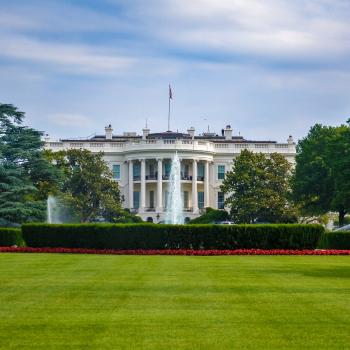
Last week, over at the Catholic legal theory blog, Mirror of Justice (which posts some great stuff!), Robert Vischer, dean of St. Thomas Law School, commented on the recent statement from Southern Baptist seminary presidents denouncing Critical Race Theory (CRT). Vischer’s post (“Staying Calm About Critical Race Theory“) features an increasingly common, and I think misguided, take on CRT but one that is worth engaging, nevertheless.
First off, our point of agreement should be established: I too do not think its time to panic (I have written to that effect here). Vischer’s plea for calm is, doubtless, rooted in the confidence derived from his faith, as is mine. I also think that SBC leaders need to find a better approach to the subject and that their various statements over the past two years have done little to allay confusion.
Where we disagree is on the nature of the threat. Vischer thinks, in general, that CRT is just not that big of a deal. I disagree. Vischer is also right to note the (somehow still) high level of confusion on the subject in Christian circles. Maybe this post will chip away at some of that; I think Vischer’s only adds to it, of course, unintentionally.
After recalling the recent SBC statement, Vischer sketches some of the basic tenets of CRT drawn from Delgado and Stefancic’s well-known primer.
First, racism is “ordinary, not aberrational,” and so it is difficult to root out apart from the most glaring examples (i.e., we can end lynching, but it’s much more difficult to end employment discrimination). Second, because racism can advance the material and psychological interests of white people, there is limited incentive to eradicate it. Third, race is a product of social thought, not biology, and societies racialize different people at different points in history. Fourth, no person has a single, unitary identity, and “everyone has potentially conflicting, overlapping identities, loyalties, and allegiances.” (This is intersectionality.) And finally, because of their different life experiences, people who are Black, Indian, Asian, or Latino/a may be able to communicate insights that white people are unlikely to know on their own.
A few clarifications of this characterization are in order (taken in the order above).
First, by racism being “ordinary,” CRT theorists also mean that it is endemic to western institutions. It is systemic. It is also permanent. It is difficult to root out because it adapts to changing social conditions, but it remains ubiquitous and hegemonic. At present, it expresses itself through restrictive, allegedly racialized norms and values like objectivity, meritocracy, colorblindness, equality of opportunity, individualism, race neutrality, and the nuclear family.
Second, Vischer is referring to Derrick Bell’s “interest convergence,” or what Delgado calls “material determinism.” This is how Bell (and Delgado) explains away almost any progress in race relations in America: everything from Brown v. Board (1953) to the election of Barack Obama. The idea is that whites only cede power to the marginalized non-whites when it is, on balance, conducive to the maintenance of the status quo. It’s an insidious tactical retreat. (Speaking of Bell, his short story, “Space Traders” is must-read CRT material. It’s a great example of “storytelling,” a key CRT strategy.)
Third, that race is a social construct is the most unobjectionable part of CRT, one that few would deny.
Fourth, this is a particularly bad representation of intersectionality, its meaning and purpose. (See below).
Lastly, this is also a tame description of the role of critical consciousness (or “lived” experience”) in CRT. This is not Vischer’s fault. Its an almost verbatim quote from Delgado and Stefancic. As other CRT’ers explain, critical consciousness is central to CRT. It is a heightened sociopolitical awareness of relative power dynamics and one’s place in them (see also “reflexivity”). It is something akin to Marx’s class consciousness blended with a heavier does of standpoint epistemology. It is a liberative epistemology, one that is only available to the marginalized and oppressed but nevertheless enables them to see the world (and “texts”) as it really is. Oppressors are blind to this knowledge because they benefit from the status quo. And, as Paulo Freire held, the critically conscious actually liberate the unconscious as well through their critical action.
I would further add that CRT, despite its split from the Critical Legal Studies (CLS) movement, still maintains a fundamentally Marxist outlook on law in that it conceives of law as inescapably political, indeterminate, and an apology/justification for power. In more Gramscian terms, law is ideology and a key component of the hegemony. The only thing CRT really ditched that belonged to CLS was its proclivity for “trashing,” armchair philosophizing, and impatience with any “rights rhetoric.”
Next, I will deal with Vischer’s three main points in turn: 1) CRT offers a Biblical understanding of sin; 2) compared to other legal theories, CRT is negligible in its influence; and 3) CRT is non-comprehensive.
1.
CRT offers insights that may take Christian teaching more seriously than many Christians do. Consider, for example, the contentious issue of systemic racism. If the Fall tainted only individual choices and left our human-created systems untouched, that would be a surprisingly weak – and unbiblical – understanding of Genesis 3’s far-reaching effects.
Moreover, some Christians have rooted their opposition to CRT in what amounts to a radical individualist worldview – i.e., ‘I didn’t engage in slavery or Jim Crow, so what does racism have to do with me?’ The Bible is filled with stories of sin’s collective consequences extending across generations, and the Christian understanding of the human person is rooted in mutual dependence. Those truths are not lost on CRT.
However, the claim of CRT vis a vis systemic or structural racism is not that said structures provide a conduit for sinful actions at scale—undeniable per Genesis 3, Romans 1, and a host of other passages—something I’ve affirmed here. Rather, it is that the structures themselves are irreparably racist to the core and that any behavior or policy enabled thereby is an expression of the inherent racism of the structures.
As Eduardo Bonilla-Silva’s much-cited book argues, within a CRT paradigm, racism need not necessarily have individual racists (in the traditional sense of the word) to exist. Racism, for CRT, is no longer personal animus on the basis of ethnicity or skin color, but complicity in the status quo of a white dominant society. This definition and conceptual shift, ironically, chips away at the moral weight of the sin of racism. Redemption is only possible via the divestiture of whiteness—social capital generated by being politically/socially designated white (which now included Jews and Asians, apparently)—a penance that is channeled through an activism of self-flagellation (otherwise known as being an “ally”) but remains impossible to fully attain. Even Robin DiAngelo admits that she is racist, and no less racist (in her mind) than Donald Trump. So long as she benefits from a white supremacist society—which has also been redefined—she is a racist.
No Christian would deny that sin has enduring consequences. The fact that CRT has occasion to be debated in Christian circles alone evidences the repercussions of chattel slavery and segregation. But CRT is not just interested in the repercussions or long-term consequences of now outlawed Jim Crow laws or redlining policies. Rather, it posits that racism is endemic, permanent, ubiquitous, and ordinary in western society, indeed, that western society itself is irredeemably racist in its norms, narratives, customs, values, and institutions. Christianity itself is considered an oppressive ideology, guilty of colonizing the minds of indigenous peoples and destroying non-white “ways of knowing.”
2.
The second contention of Vischer is delivered through an analogy to the Law and Economics (L&E) movement. Given that Vischer is a torts professor, this is not altogether surprising—and it induced unwelcome flashbacks to encountering Coase’s theorem for the firs time my 1L year.
Vischer’s maneuver has been performed by others as well. CRT is a legal theory, what’s the big deal? As he puts it, “I have not seen many joint statements from Christian leaders making sweeping condemnations of Law & Economics. Such a condemnation, in my view, would also be imprudent.” It would also be strange. Why would the SBC or any other denomination care about the latest intramural debate at the University of Chicago?
The problem with this assertion by Vischer is twofold.
First, a L&E to CRT comparison is, in many respects, one of apples to oranges, the only real commonality being that, as Vischer points out, they both originated in the legal academy and are, to some extent, both concerned with legal outcomes.
Most evidently, CRT differs from L&E in it outlook on law generally, some of which was already mentioned above. CRT’s is basically that of CLS’s, as I mentioned above. John Finnis has sufficiently critiqued this approach to law in the thought of Roberto Unger before. Good critiques of CRT, pertaining to its view of law—approach to precedent, legal norms, procedure, etc.—directly have been offered by Jeffrey Pyle, Randall Kennedy, and Daniel Subotnik.
L&E may present an alternative theory of remedies, forms of adjudication, and the like via microeconomic analysis, but it does not strike at the root of the conception of law itself, nor does it present a comprehensive legal theory. (“Economic constitutionalism” never really caught on, did it?) CRT does both. But that is a subject for another post.
Second, Vischer underestimates the influence and expansion of CRT, which far outpaces that of L&E—the two aren’t in the same ballpark; they’re not even playing the same sport.
CRT now encompasses far more disciplines than law; it is no longer just a legal theory. It has spread its tentacles into education, geography, foreign policy, sociology, literature, and art, and has spawned its own subdisciplines like critical whiteness studies and intersectional studies. (And this doesn’t account for related critical social theories like postcolonial studies that have their own origin story apart from CRT; but crosspollination is a feature of critical theories, as I’ve shown regarding CRT and Critical Animal Studies.)
More importantly, however, in terms of influence, CRT has long ago breached the walls of the college quad. Is there a L&E equivalent to Black Lives Matter (or the Movement 4 Black Lives)? Do L&E scholars get $10m grants from Twitter’s Jack Dorsey? Does L&E educators charge $6k per hour to tell university faculty and administrators how racist they all are? Does any law school have a special L&E-oriented J.D. program? Even George Mason on has a L.L.M., not a J.D., L&E program. Which L&E proponents get interviewed by Time, or are the subject of 9k word exposés in the New York Times Magazine? (Justice Posner, who somehow managed to make L&E cool, might be the only exception to the latter.) “White fragility,” “white privilege,” “intersectionality,” and “systemic racism” are now mainstays of the popular lexicon. The kids aren’t talking about allocative efficiency, they’re talking about “internalized oppression” and “aversive racism.” Would that it was the former.
But what about the academy? Coase’s “Problem of Social Cost” article may be the most cited law review article of all time; one by Calabresi is sixth. Both articles were written between 1960 and 1972. At seventh, however, is Charles Lawrence’s famous 1987 article for the Stanford Law Review on unconscious racism (with a hint a Freud, just like the Frankfurt Schoolers did). Duncan Kennedy, of Critical Legal Studies fame, is fourteenth. Angela Davis on race essentialism and feminist legal theory is not far below Kennedy. Crenshaw’s first ever article is the 32nd most cited; another one is 44th. Mari Matsuda, a founding member of CRT, is 33rd. Delgado’s work sits at 68th. Matsuda (again), Catharine MacKinnon, Alan Freedman, and Neil Gotanda, fill out the last block (85-100)—all just as, or more, recent than Lawrence’s. Not a bad showing for an upstart block of legal academia that’s only been around since the 1980s (and L&E had a sizeable head start).
The point is that the past twenty years have witnessed the ascendency of CRT. It has a growing influence in academia generally, not just law, and it increasingly dominates the new legal scholarship. If I were to place a bet on the which theory would have (or has) the most influence over the next twenty years, my money would be on CRT. (The list above only runs through 2012, but in several of the years from 1998 to 2009, articles by CRT scholars are in the top five most cited.)
I could go on. But the best illustration of the discrepancy between CRT’s and L&E’s reach is that only one of them has been instrumental in galvanizing national political movements. (And if you don’t think that CRT has influenced BLM and its affiliates, see here and here.) Before “defund the police” became a slogan, it was being theorized by CRT law professors, just like race-based jury nullification, and prison abolition.
Love it or fear it, CRT is growing in influence and not likely to go anywhere.
3.
Vischer closes with, “CRT is not a comprehensive Christian theory of the world, nor does it aim to be.” The first clause is undoubtedly true. It is not a Christian theory of the world, comprehensive or otherwise. In fact, as Brandon Paradise has argued, CRT routinely marginalizes the African American Christian tradition. But the logic of CRT is all-encompassing.
Intersectionality, for instance, (which Vischer mentions) is not simply a hip new way to appreciate how unique we all are. It is not individualism, as some libertarians erroneously suggest. Nor is it a benign analytical tool to be picked up and discarded at will.
It is, as I have described it, a disposition or sensibility. I did not invent this description. Kimberlé Crenshaw, the codifier of intersectionality, did. In a 2013 edition of Signs, Crenshaw dubbed intersectionality a sensibility that must pervade the scholarship of any discipline engage by the critical theorists. (She referred to it an “analytic sensibility” in a recent Washington Post op-ed.) Here’s Crenshaw:
[I]ntersectionality is best framed as an analytic sensibility. If intersectionality is an analytic disposition, a way of thinking about and conducting analyses, then what makes an analysis intersectional is not its use of the term ‘intersectionality,’ nor its being situated in a familiar genealogy, nor its drawing on lists of standard citations. Rather, what makes an analysis intersectional…is its adoption of an intersectional way of thinking about the problem of sameness and difference and its relation to power.
And the purpose of this sensibility is to critique how structures of power marginalize through “multilayered and routinized forms of domination,” as Crenshaw put it in her 1989 article. The point was to enhance the vision of the hegemony held by critical scholars.
The theoretical significance of intersectionality for CRT is rarely truly appreciated. As I’ve more fully argued elsewhere, as a mid-level mechanism working within and upon the assumptions and commitments of CRT, it acts as the linchpin that enables ground level application of CRT’s insights. Importantly, intersectionality has also expanded CRT’s analysis. By discarding single-axis frameworks and conceiving of all oppressions as intersecting, interlocking, and mutually reinforcing along multiple axes within the matrix of domination, intersectionality allows CRT to consider more than just race, but also sex, sexual orientation, gender identity, and much more. In short, it has supplied CRT with endless application. Intersectionality theorizes power in order to empower (critical) theory.
CRT also has at least the potential to function as a comprehensive worldview, that is, a religion. As manifested in the Social Justice Movement (SJM), CRT exhibits all the Durkheimian hallmarks of a religion, or rather, a worldview. Andrew Sullivan, John McWhorter, and James Lindsay have all drawn attention to this characteristic of SJM. (And Adrian Vermuele has rightly included Herbert Marcuse, by all accounts a founding father of critical social theory, in his assessment of “sacramental liberalism.”)
I don’t want to belabor the point(s) any more than I already have. CRT is more than my digital interlocutor makes of it. This is not cause for panic. We should stay calm but get real.
Hopefully the above will, at minimum, generate further discussion. None of it, of course, is intended as an attack on Dean Vischer himself, only critical engagement (see what I did there?).
Image credit: @nate_dumlao/Unsplash












